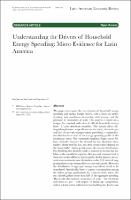| dc.creator | Jimenez Mori, Raúl |
| dc.creator | Yepez-Garcia, Ariel |
| dc.date.issued | 2020-12-23 |
| dc.identifier.issn | 2196-436X |
| dc.identifier.uri | http://hdl.handle.net/11651/4678 |
| dc.description | Energy expenditures, Engel curves, household surveys, Latin American countries |
| dc.description.abstract | The paper investigates the determinants of household energy spending and energy budget shares, with a focus on understanding their non-linear relationship with income, and the presence of economies of scale. The analysis is based on a unique, harmonized collection of official household surveys from 13 Latin American countries. This dataset allows distinguishing between expenditures on electricity, domestic gas, and fuel for private transportation, providing a comprehensive distributional view of the energy spending profile of the residential sector. The estimated empirical Engel curves behave similarly; however, the derived income elasticities show marked distinctions by fuel, and their actual values depend on the households’ relative position over the income distribution. For electricity, the elasticity tends to increase in income but stabilize at the wealthiest segments. For gas and transport fuel, it decreases under different income paths. In this dataset, the examination returns income elasticities on the (0,1) interval, suggesting that energy commodities are necessity goods. However, the distribution of aggregate energy expenditure needs to be considered. Specifically, there is a great concentration among the richer groups, particularly for transport fuels, where the top quintile gathers more than half of the aggregate spending. The results also indicate economies of scale ––for electricity and domestic gas–– with respect to family-age composition, and to a lesser extent with respect to dwelling size. In the case of electricity, these economies are more pronounced for richer households. These results join the previous literature in emphasizing the relevance of accounting for household demographic and socioeconomic trends for energy management. |
| dc.format | application/PDF |
| dc.language.iso | eng |
| dc.publisher | Centro de Investigación y Docencia Económicas |
| dc.relation.ispartof | Latin American Economic Review, volumen 29, diciembre de 2020 |
| dc.rights | La revista Latin American Economic Review autoriza a poner en acceso abierto de conformidad con las licencias CREATIVE COMMONS, aprobadas por el Consejo Académico Administrativo del CIDE, las cuales establecen los parámetros de difusión de las obras con fines no comerciales. Lo anterior sin perjuicio de los derechos morales que corresponden a los autores. |
| dc.source | 2196-436X |
| dc.title | Understanding the drivers of household energy spending: micro evidence for Latin America |
| dc.type | Artículo |
| dc.accessrights | Acceso abierto |
| dc.recordIdentifier | 000004678 |
| dc.rights.license | Creative Commons Reconocimiento-NoComercial-SinObraDerivada 4.0 International CC BY-NC-ND |
| dc.identifier.citation | En: Latin American Economic Review, volumen 29, diciembre de 2020 |
| dc.identifier.doi | https://doi.org/10.47872/laer-2020-29-3 |
| dc.relation.dataset | https://t.co/1tfCuITJ5d?amp=1 |
| dc.identifier.url | https://www.latinaer.org/index.php/laer/article/view/5 |


